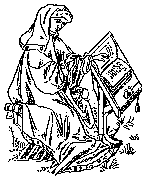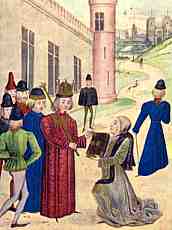 |
|
Histories,
Chronicles and Annals (4) |
|
In
the later middle ages, monks were still learned and literate, but monastic
communities were less enclosed from the world. Abbots went to parliament
and monasteries built large guesthouses to accommodate increasing numbers
of travellers going about all kinds of business. After the 12th century,
monasteries became less inclined to have their members sitting down in
scriptoria
transcribing
their liturgical
books, and much more inclined to purchase them from stationers in town,
as the lay people did. The monasteries still produced their chronicles,
but the authors were much more connected to the affairs of the world. |
 |
The
late medieval guesthouse at St Mary's Abbey, York, now restored, was a substantial
and commodious structure. |
|
In
the 13th century the abbey of St Albans was particularly well located to collect
the gossip and travellers' tales doing the rounds, as the abbey was just one
day's travel from London on the Great North Road. It had an enormous guesthouse,
visited by all the top people from the ecclesiastical and lay world. The chronicler
Matthew Paris provides a more vivid view of contemporary life than the monastic
chroniclers of earlier times. |
|
|
Matthew
Paris, as drawn by himself. |
|
Matthew
Paris in some ways resembles a figure from earlier centuries, as he was
author, scribe
and illustrator of his own works. Perhaps this reflects the decrease in
book copying in the monasteries, and consequent dearth of specialist scribes
and illustrators. There are three autograph
volumes of his main work, the Chronica Majora,
in existence, covering, in traditional medieval form, all history from
the Creation to the time of his death. |
|
While
the format might have been traditional, the later chronicle entries are not
dry recitations of the facts of the year. A book review printed on the back
of a recent translated edition refers to him as a "tabloid monk". There is a sequence of stories
of violence, fraud and sexual misconduct, presented in lively form along with
his harshly critical opinions of people he did not approve of, like popes
and their legates, Franciscans, and men, ecclesiastical or lay, who engaged
in slimy politics. He evidently tried to tidy up the record before his death
and excised and erased various unflattering passages, but fortunately for
posterity, a copy of the unaltered work had already been made. |
|
The
contemporary entries, as well as the copious illustrations, give us a vivid,
if not unprejudiced, picture of life in the first half of the 13th century.
In these entries he was not writing history, but for history. It may well
also reflect the way that the written word was escaping from being a reflexive
study of its own history, and was becoming a part of broader culture. The
tales and anecdotes were no longer being left for oral performers to embellish
on the core facts, but were being recorded for eternity by the chronicler. |
|
This
need to put the stories, as opposed to the bare facts, in writing may
have sometimes led to some retrospectivity. The chronicle of Croyland
Abbey, supposedly written by the abbot Ingulphus around the beginning
of the 12th century, contains a graphic eyewitness account of a fire in
the abbey, among other things. The only trouble is, it may not have been
written until the 14th century. This, like the forged charters
possessed by some abbeys, was probably not perpetrated in the spirit of
fraud. There came a time when it was necessary to put oral stories and
corporate memory into the form of the written word. |
|
|
Part
of the ruins of Croyland Abbey. |
|
In
the 13th and 14th centuries lay literacy was increasing. This means not
only lay readers, but lay writers. Vernacular writing became common, and Latin was no longer privileged as the language
of everything that mattered. The literate traditions of constructing a
text that had lasted so long in the monasteries were no longer essential
in new experiments in lay vernacular writing. It wasn't necessary to start
a chronicle with Adam. |
 |
The
most famous of these new lay chroniclers, Froissart, wrote of the period
of the Hundred Years War between England and France, during the course
of the 14th century. The early part of his work is based on an earlier
Chronicle of Jean le Bel, a knight and soldier,
while the latter part is based on his own observations and what he heard
around the traps. He has been described as more a war correspondent or
a journalist than a historian, as he was writing of contemporary events.
He revised his own work, so that there are various editions. He was also writing for history, rather than writing history. |
|
Froissart |
|
Froissart
is evidently a little flaky when it comes to the precise recording of
points of detail such as dates, places and the precise military strategy
of any particular event. His fascination for modern readers lies in the
observations of society and its moral attitudes, all from the perspective
of someone who waltzed around the royal courts when there were English
and French people, but France was not France and England was not England
as we understand those concepts today. This is the old oral storyteller,
now armed with a pen, creating pictures in the minds of his audience. |
|
A
lay chronicler did not have permanent bed and board and a supply of parchment
and quills provided by his monastic home. The lay chronicler was dependent
upon patronage, and that no doubt sometimes influenced just how and what
he wrote. Froissart had both French and English patronage and connections
at various times. This just adds a bit more fun for the modern reader
as they attempt to analyse the influences on the writer. |
|
|
Froissart
presents a volume of love poetry to Richard II. |
 |
Froissart's chronicles were produced in fancy illuminated and decorated editions for lay readers, like the lavish volumes of romance which evolved and developed at about the same time. |
| Charles VI meets some armed Parisians. After a Froissart manuscript (Bibliothèque nationale ms 2644). |
| At this point there develops another twist in the convoluted relationship between fiction and history, romance and chronicle. Stories of King Arthur were not the only chronicle events which had become elaborated into heroic fiction in the form of romance. The same had occurred with stories of the deeds of Charlemagne, a man who undoubtedly existed but whose legends had gained accretions from folklore all over western Europe. The Song of Roland is a highly mythicised account of a nasty incident in which Charlemagne's army, returning from Spain after successful assaults on the Saracens, were attacked in the Pyrenees by some marauding Basques. The legend changes a nasty incident in the mountains into a heroic and tragic epic involving Saracens, presumably more worthy enemies than Basques, and a legendary hero with a magic horn. |
| The story of Roland found its way back into the chronicles, embellishing the terse historical accounts of Carolingian history with a bit of national mythology. Furthermore, pilgrims from France travelling the pilgrimage route to Santiago de Compostella could visit the tombs of the legendary heroes at the site of their demise as they crossed the Pyrenean pass at Roncevalles, at the monastery founded on the site. |
|
| Charlemagne finds the body of Roland, in complete 15th century armour, in a miniature by the famous manuscript painter Jean Fouquet in a copy of the Grandes Chroniques de France (Paris, Bibliothèque nationale). |
|
No
history stands outside of its society, or of the subset of society where the
author resides. Monastic chroniclers reflect their position within the formal
structure of the western Christian church. Lay writers reflect their position
in a certain stratum of society and the prejudices of their patrons. It is
as unreasonable to expect a medieval historian or chronicler to have produced
a totally unbiased account as it would be to expect a soldier in the trenches
to produce an analytical and dispassionate account of the First World War.
Anyway, it is because of their unique perspectives, biases if you like, that
these old written words are still fascinating to us today. |
 previous
page previous
page |
 Categories
of Works Categories
of Works |
|
 |
 |
 |
 |
 |






